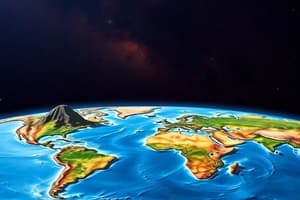Podcast
Questions and Answers
Which of the following scenarios primarily demonstrates differential ground settlement following an earthquake?
Which of the following scenarios primarily demonstrates differential ground settlement following an earthquake?
- A bridge support failing due to the displacement of the ground beneath it.
- A structure experiencing uneven sinking, causing cracks in its foundation. (correct)
- A hillside collapsing and burying a road after prolonged shaking.
- A building sinking uniformly into the ground after sustained vibration.
Lateral spreading, a direct effect of earthquakes, is most accurately described as:
Lateral spreading, a direct effect of earthquakes, is most accurately described as:
- The horizontal movement of soil towards a free face, such as a riverbank. (correct)
- The cracking and fracturing of the earth's surface along fault lines.
- The vertical sinking of land due to the compaction of soil.
- The rolling and undulating movement of the ground surface during an earthquake.
Which of the following earthquake-induced effects is categorized as both a direct and indirect consequence?
Which of the following earthquake-induced effects is categorized as both a direct and indirect consequence?
- Soil liquefaction
- Landslides (correct)
- Tsunami
- Seiches
Why would soil liquefaction pose a significant risk to buildings during an earthquake?
Why would soil liquefaction pose a significant risk to buildings during an earthquake?
Following an earthquake, a coastal city experiences a series of unusually high and destructive waves. This is most likely an example of:
Following an earthquake, a coastal city experiences a series of unusually high and destructive waves. This is most likely an example of:
Flashcards
Ground shaking
Ground shaking
The perceptible movement of the Earth's surface, caused by seismic waves.
Ground cracking
Ground cracking
Open fissures or breaks that appear on the ground due to the intensity of the earthquake's forces.
Ground lurching
Ground lurching
Wave-like movement or staggering of the ground surface during strong ground shaking.
Differential ground settlement
Differential ground settlement
Signup and view all the flashcards
Soil liquefaction
Soil liquefaction
Signup and view all the flashcards
Study Notes
- Earthquake outcomes are categorized into direct and indirect effects.
Direct Effects
- Ground shaking occurs
- Ground cracking occurs
- Ground lurching occurs
- Differential ground settlement occurs
- Soil liquefaction occurs
- Lateral spreading occurs
- Landslides occur
- Rockfalls occur
- Vibrations of structures occur
- Falling objects occur
- Structural damage occurs
- Structural collapse occurs
Indirect Effects
- Landslides occur
- Tsunamis occur
- Seiches occur
- Avalanches occur
- Rockfalls occur
- Floods occur
- Fires occur
- Toxic contamination occurs
Studying That Suits You
Use AI to generate personalized quizzes and flashcards to suit your learning preferences.




